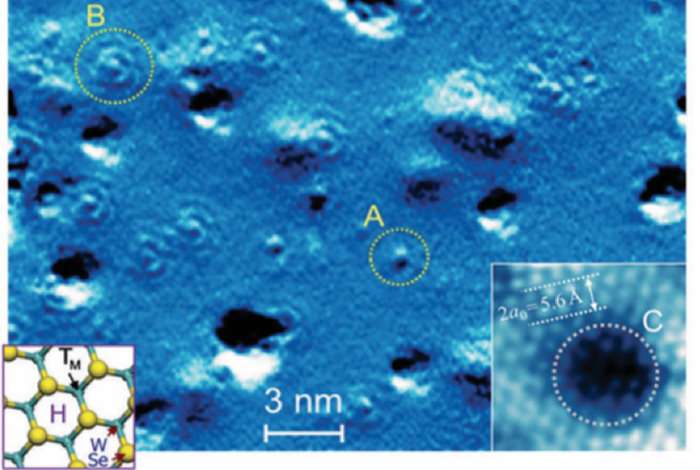The ring-shaped patterns on this image represent the optical phonon condensate droplets scattered all over the surface of quasi-freestanding WSe2 island. Credit: Los Alamos National Laboratory
In a recently published open-access paper in the journal Nature Scientific Reports, scientists reported the observation of a room-temperature condensate of optical phonons, called a Bose-Einstein (B-E) condensate.
"We did not predict this B-E condensate in our model. This is an absolutely new observation," said Alexander "Sasha" Balatsky of Los Alamos National Laboratory, a coauthor on the paper with a research team from Air Force Research Laboratory, The Pennsylvania State University, Los Alamos National Laboratory and the Nordita Center for Quantum Materials, KTH Royal Institute of Technology and Stockholm University.
The new substance may be useful for phonon-based quantum computers, and it may also shed light on the conditions required to form biological Fröhlich condensates of collective modes.
Bose-Einstein condensation (BEC) is a fascinating phenomenon, one that results from quantum statistics for identical particles with an integer spin, called bosons. Sometimes referred to as the fifth state of matter, it was originally predicted in 1924 by Albert Einstein and Satyendra Nath Bose. In a BEC, matter stops behaving as independent particles, and collapses into a single quantum state that can be described with a single wave function. Usually this phenomenon occurs for dilute atomic vapors and only at extremely low temperatures.
BEC involves the formation of a collective quantum state if the particle density exceeds a critical value. For quasi-particles, such as phonons or magnons, BEC may occur at elevated temperatures, and possibly also at room temperature, as seen in this experiment, because their density increases with temperature.
For observation of this phenomenon, the researchers used atomically thin sheets of tungsten diselenide, a two-dimensional semiconductor, which was supported by a small density of molecules, like a thin membrane on isolated pillars.
Using quantum tunneling of electrons into vibrating surface atoms, phonon condensate oscillations were observed on the atomic scale. "The condensate droplets formed in the 2-D monolayer of WSe2," said Igor Altfeder, of the Air Force Research Laboratory (AFRL/UTC), lead scientist on the project "The molecular pillars facilitate the creation of condensate in WSe2 by means of enhancing phonon-phonon interactions."
The condensate was observed using a scanning tunneling microscope, and it appeared in the form of small droplets, whose radius is several nanometers, developing around the supporting molecular pillars. The authors explain that each pillar acts as a synchronizing agent and causes the phonons inside the tungsten diselenide atomic sheet to synchronize their oscillation phases, in a close analogy to synchronization of multiple atomic clocks, thus creating the BEC.
More information: Igor Altfeder et al. Scanning Tunneling Microscopy Observation of Phonon Condensate, Scientific Reports (2017). DOI: 10.1038/srep43214
Journal information: Scientific Reports
Provided by Los Alamos National Laboratory
























